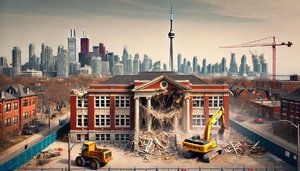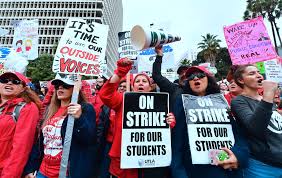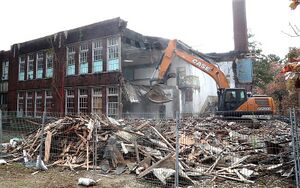Group 2: Difference between revisions
No edit summary |
No edit summary Tag: Manual revert |
||
| Line 1: | Line 1: | ||
In *MONTH* 2048, all public high schools in Toronto were torn down replaced public housing as a result of the implementation of the Schools into Housing Act, which attempted to mitigate the housing crisis. Since September of 2048, all high school students have been learning remotely, online. | In *MONTH* 2048, all public high schools in Toronto were torn down replaced public housing as a result of the implementation of the Schools into Housing Act, which attempted to mitigate the housing crisis. Since September of 2048, all high school students have been learning remotely, online. | ||
[[File:Toronto High School Torn Down.webp|thumb | [[File:Toronto High School Torn Down.webp|thumb|Toronto high school torn down as a result of Bill 325 SHA]] | ||
== Prelude/Background == | == Prelude/Background == | ||
Revision as of 19:04, 30 November 2024
In *MONTH* 2048, all public high schools in Toronto were torn down replaced public housing as a result of the implementation of the Schools into Housing Act, which attempted to mitigate the housing crisis. Since September of 2048, all high school students have been learning remotely, online.
Prelude/Background
Implementation
Bill 325 SHA - The Schools into Housing Act was seen as a way to mitigate the rising homelessness crisis within Ontario, especially since the increase in the population was straining government systems. The Canadian government’s plan to implement this bill was first to survey the areas to determine which schools would be torn down to build affordable housing. The surveying of areas took the most time as it required considering certain factors, such as area density (How many people are living within a specific area), spatial space (If there was enough space to build), and impacts on the community. The plan initially proposed that some schools be torn down and converted into housing; however, from the surveyor’s data, the reports indicated that the area density was too high and tearing down some schools would not mitigate the homelessness crisis. There were too many homeless individuals in an area, and surveyors concluded that tearing down some public high schools would not decrease that number. As such, the Bill was modified to include all public high schools to be torn down as it would offer the solution to the ever-growing issue and accommodate the majority of homeless individuals.
Moreover, according to surveyors’ reports, schools took roughly 45% of spatial space in relation to the overall space within a specific community area, with 35% being high schools and 10% being elementary schools. The other percentages were residential, commercial, and industrial buildings. By tearing down high schools and building housing, 35% of the space that they occupied would increase residential building capacity to accommodate the high increase of homeless individuals. Reports also indicated that one school’s spatial space can accommodate 15% of the homeless individuals living within the community. With all the schools torn down, it can house 100% of these individuals and even have some space to accommodate others. The report on spatial space was one of the deciding factors by which the Canadian Parliament decided to push the Bill to pass and implement it first within Ontario.
After the Canadian Parliament passed Bill 325 - SHA, the next step was to notify the community and the students on how to proceed with education. Before tearing down schools, the government held various programs and outreach to inform the community on how teaching and student learning would occur in homes. Given that resources were already created for at-home learning due to the pandemic in the year 2020, the transition from in-person learning to at-home learning proved to be smoother than expected. However, some argue it could have been a smoother transition as teachers needed proper training in teaching students using this method. Protests erupted both from teacher unions and other community members against the Bill. However, despite their protests, the Bill moved forward, and both teachers and community members were forced to adjust to these changes. As a result, private school enrollment reached its capacity as these schools were exempted from the bill since the government did not publicly fund them.
Once the communities were informed of how education would proceed, schools were torn down to begin building new housing. The projected time to tear down and build these buildings is 15 years. However, Parliament urged that the tearing down and building must be prioritized and take less time if possible. As such, this urgency helped slightly with the economy as construction companies needed more individuals, thus creating jobs. Although there was an increase in the saturation of construction workers, the funding these companies received could not adjust the pay these workers should have been paid. However, because the homelessness crisis heavily strained the Canadian economy, individuals took these construction jobs because they provided some income for them. With the increased labour, the projected timeline was reduced from 15 to 7 years. As the construction began, the public high schools in downtown Toronto were torn down first. They would then start tearing down schools as the projects in downtown Toronto were completed, working their way towards the suburbs and then further schools away from the cities until they were all converted into affordable housing.
A few months before the demolition of public high schools, the Boards of Education in Ontario implemented a revised version of at-home learning based on the plans for the 2020 COVID-19 years. This revised educational method introduced what is now called “Virtual High School Learning.” As the name suggests, this schooling method allows high school students to learn from home using their electronic devices and online platforms such as CanComm and Microsoft Classroom. However, with the advancement of technology, many have indicated that virtual reality would soon be an option. The Canadian Parliament, in accordance with the Ministry of Education, has argued that virtual learning is the most effective method to teach high school students. However, critics have had their fair share of opinions regarding this method, especially concerning students’ mental health and the effects on teachers.
As Virtual High School Learning was implemented, students and teachers had difficulties adjusting to this method of learning and teaching, which were reflected in the student assessments. Reports from various school boards indicated that student grades fell by 30% compared to when they were in-person. With this decline, school boards invested more into training teachers to better teach and support their students. This investment allowed teachers to receive the support and resources they desperately needed, consequently permitting them to find innovative and creative methods for teaching. With support, teachers could adapt and adjust their teaching styles to accommodate the restrictions of virtual learning leading to an increase in students' grades. Over time, reports later indicated that students did better through virtual learning compared to in-person learning.
Despite the criticisms after the Bill was passed, virtual learning became the better teaching and learning method. Not only were teachers better supported, students also excelled in their academics because of the support their teachers received, allowing for more interactive teaching styles and methods. Furthermore, reports have indicated that homeless individuals and low-income families benefitted from virtual learning as, through this method, parents were able to be more involved with their children and their education. As parents became more involved, students felt supported and guided, resulting in better grades and the overall quality of their work. Despite seeing a 30% decrease in student grades at the beginning of this change when the Bill was passed, it has been constantly rising, with a 57% increase, which will continue according to recent reports.
Education
Impacts on Teachers
Impacts on Students
The shift to online school for high school students happened quickly and with very few technological issues, as schools had already begun incorporating online learning for the past few decades. High school students, having grown up in an age of technological advancement had become accustomed to using online learning platforms; however, the switch to completely full-time online learning created new barriers for learning that teachers, especially those that had spent a majority of their career in in person classes, were not prepared to address. Thus, the first couple of years of the implementation of online school were defined by a string of trial and error in the education system.
During the first few years of the switch to online school, engaging students was a major issue. Students reported being more easily distracted when learning online. Although online learning platforms took measures to prevent distractions like browser locking technology on learning devices ; other personal electronic devices could not be controlled. Furthermore, the increase in class sizes due to the shortage in teachers made monitoring student attention a difficult task. In a Found Journal from 2048, a grade 10 student recounts her classmate leaving their workspace for an entire period and going unnoticed by her teacher. As a result of lack of engagement, academic performance in Toronto’s public board decreased drastically. As private schools were unaffected by the shift, the gap in university enrolment between students from the public board and students from the private board increased and as did failure rates for first year university students from Toronto.
However, within a couple of years, teachers adapted and created ways to overcome the barrier of online learning. New curriculum was created, and new teachers were trained within the context of full-time online school. Students too, adapted to the online format. Parents, having seen the success of Bill 325 SHA in reducing homelessness in the city, encouraged their children to accept the change and do the best they can to learn online. That being said, many parents, who could afford it, transferred their children into private schools. Enrolling into these schools, thus, had become and remained even more competitive and expensive.
Another impact on student life was the lack of opportunities for student socialization, which is integral to their development. During the start of the shift to online schooling, the board attempted to mitigate the expected negative social effects of online school by allowing students to attend online class sessions in a “buddy system”. This reduced feelings of isolation for some; while, others could not host others or go to other people's homes during school hours for various reasons like lack of transportation, lack of space, social difficulties, and conflicts in the family.
While extra curricular activities were not canceled amidst the shift to online learning, the shortage in teachers and the lack of common space significantly reduced the number of clubs and sports teams in Toronto’s public board. As the school’s tracks and fields were replaced by housing, finding terrain in which student athletes could practice became difficult. In 2048, when the switch had finally been implemented school sports teams were allotted training spaces in community center fields and parks based on performance, meaning weaker performing schools would not have anywhere to practice. This competitive system strongly upset students, and was abandoned from September 2049, forward. Currently, practice spaces are distributed evenly between all schools, even if that only allows for some teams to practice twice a week. Some clubs, like creative writing, debate teams, chess clubs, and others, that could be held online and in different locations survived the shift, although there remained a strong preference for in person activities; however, similarly to sports teams, finding a location to host these events was a problem, especially during colder months.
The shift to online learning for high school students lead to a large increase in social activity after school hours for many students. Students congregate in large groups in parking lots, malls, parkettes, cafes and at each other’s homes. Furthermore, as these congregations were done so privately, some students were completely excluded, a consequence that could not be regulated by the school board. During the colder months of the winter, students were physically unable to spend time together in large groups, and these periods are often marked by reports of poor mental health by students.
Other Impacts
Works Cited
OpenAI. (2024). ChatGPT (Nov 30 version) [Large language model]. https://chat.openai.com


